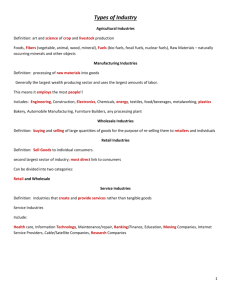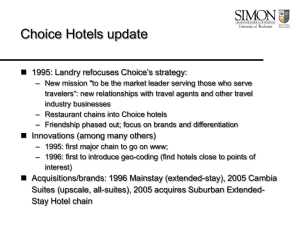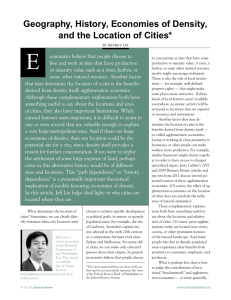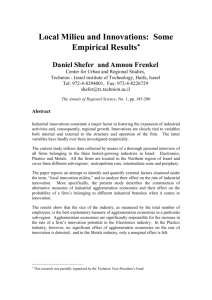Agglomeration economies - Southeast Missouri State University
advertisement
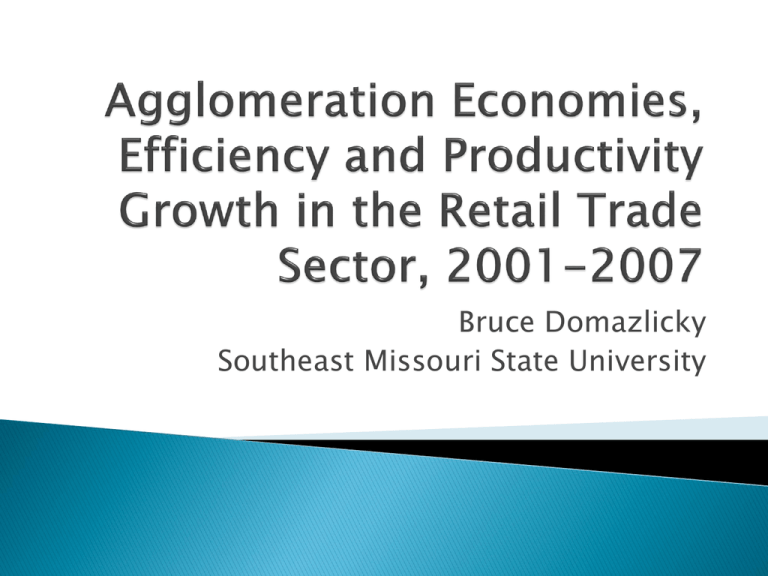
Bruce Domazlicky Southeast Missouri State University The Retail Trade Sector in the U.S. Agglomeration Economies Efficiency and Productivity Growth Model Model Results Relationship between Agglomeration Economies & Efficiency Relationship between Agglomeration Economies & Productivity Growth Important Contributor to Standard of Living in an Urban Area Supplies Goods & Services that Residents Demand Important Source of Jobs to Urban Residents Computerization: Bar Scanning Universal in U.S. Improved Inventory Tracking Increased Average Size of Retail Establishments Increased Concentration in Urban Areas at expense of Rural Areas Localization Economies: economies that arise when firms in the same industry locate near each other: pooling of labor force, development of industry suppliers, diffusion of ideas (technological spillovers) Urbanization Economies: economies that arise from locating in an urban area: access to markets, labor supply, financial and other specialized services, low communication costs Does efficiency in the retail trade sector increase with urban size? Does productivity growth in the retail trade sector increase with urban size? What is relationship between agglomeration economies and efficiency in the retail trade sector? What is relationship between agglomeration economies and productivity growth in the retail trade sector? Data Envelopment Analysis is used to measure efficiency levels Productivity Growth is measured using the Malmquist Productivity Index 348 Metropolitan Statistical Areas in U.S. 3 Variables: Output, Labor, Capital Output and Labor from the Bureau of Economic Analysis: Http://www.bea.gov Capital computed using variation on method by Garofalo and Yamarik (REStat, 2002) Table 1. Variable Statistics Variable Output (millions) Labor Capital (billions) Mean Std. Deviation Maximum Minimum 1865.217 4497.217 52536.429 107.286 42892.146 89281.836 977328 4491 1.641 4.223 46.069 0.066 Table 2. Efficiency Estimates Year Mean Std. Deviation Minimum Maximum 2001 0.7137 0.0961 0.4444 1 2002 0.7366 0.0938 0.4878 1 2003 0.7201 0.0900 0.4415 1 2004 0.7006 0.0919 0.4249 1 2005 0.6995 0.0977 0.4103 1 2006 0.6939 0.0984 0.4185 1 2007 0.6781 0.0938 0.4101 1 All 7 Years 0.7061 0.0909 0.4339 1 Table 4. Average Efficiency by Region Region Average Efficiency New England 0.7272 Mid-Atlantic 0.6869 Great Lakes 0.6892 Plains 0.6448 Southeast 0.7280 Southwest 0.6797 Rocky Mountain 0.6784 Far West 0.7556 Table 6. Average Efficiency Scores by Metropolitan Size Size Average Efficiency Score Number Less than 100,000 0.6626 23 100,001-200,000 0.6695 133 200,001-500,000 0.7081 102 500,001-1,000,000 0.7353 45 1,000,001-2,000,000 0.7789 21 More than 2,000,000 0.8230 24 Table 3. Productivity Estimates, 2001-2007 Productivity Mean Std. Deviation Minimum Maximum TFP Growth Rate 1.2530 0.0951 1.0173 1.8110 Efficiency Change 0.9524 0.0732 0.7644 1.3878 Technical Change 1.3159 0.0252 1.2187 1.3633 Table 5. Average Productivity Growth by Region Region TFP Efficiency Change Technical Change New England 1.2220 0.9208 1.3269 Mid-Atlantic 1.2599 0.9556 1.3188 Great Lakes 1.2024 0.9229 1.3038 Plains 1.2055 0.9195 1.3114 Southeast 1.2730 0.9687 1.3146 Southwest 1.2408 0.9312 1.3332 Rocky Mountain 1.3106 0.9910 1.3227 Far West 1.2774 0.9696 1.3174 Table 7. Average Productivity Growth by Metropolitan Size Size TFP Growth Rate Efficiency Change Technical Change Less than 100,000 1.3272 1.0165 1.3057 100,001-200,000 1.2593 0.9587 1.3136 200,001-500,000 1.2518 0.9523 1.3150 500,001-1,000,000 1.2387 0.9394 1.3187 1,000,001-2,000,000 1.2276 0.9229 1.3301 More than 2,000,000 1.2010 0.9071 1.3243 Regression Results AVEEFF: Average Efficiency URBAN: Urbanization Economies, log of average population LOCAL: Localization economies, relative share of retail trade output EDUC: Percentage of population with at least a Bachelor’s Degree Table 8. Efficiency Regression Dependent Variable: AVEEFF No. of Obs.: 348 Variable Coefficient Std. Error t-Statistic Constant 0.0684 0.0769 0.89 URBAN 0.0429 0.0042 10.23 LOCAL 0.0653 0.0216 3.03 EDUC 0.0022 0.0006 3.58 0.538 F-Statistic 8.77 Adj. R-Squared Regression Results PROD: Productivity growth, 2001-2007 TC: Growth rate of technical change, 20012007 EC: Growth rate of efficiency change, 20012007 Table 9. Productivity Regressions No. of Obs.: 348 (Numbers in parentheses are t-statistics.) Variable Constant URBAN LOCAL EDUC Adj. R-Squared F-Statistic PROD 1.4714 (13.86) -0.0164 (-2.82) 0.0173 (0.66) 0.0007 (0.92) 0.24 3.11 TC EC 1.2547 (62.76) 0.0048 (3.60) 0.0094 (1.22) 1.1681 (14.71) -0.0162 (-3.63) 0.0060 (0.30) 0.0001 (0.75) 0.17 2.37 0.0003 (0.62) 0.21 2.80 Efficiency in urban areas increase with city size & relative importance of sector Productivity change is due solely to technical change Efficiency change declines as urban size increases-indication of “catching-up”?





